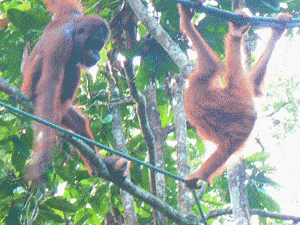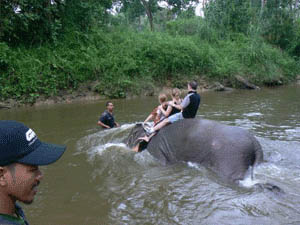Wild Creatures like Elephants, in Accessible Environments in Malaysia
By Max Hartshorne,
GoNOMAD Editor

We saw elephants taking baths, a Great Hornbill in a cage, played with monkeys and watched orangutans up close, but never had to hire a jeep, pay a steep fee or enter a big distant game park.
That’s because, in Malaysia, all of these family-friendly animal attractions are close to the cities and are easy day trips. Viewing animals in cages or out in the open provides something visceral and meaningful to any Homo sapien, and Malaysia provides many low key, low-stress parks and sanctuaries to enjoy.
Orangutans in Bomtanbong
Sarawak is one of Malaysia’s largest provinces, it was part of the Sultanate of Brunei back in the 1840s before James Brooks did the sultan a favor and subdued the headhunters who were killing each other.
He was rewarded with this huge tract of thousands of square miles, today composing the top of the island of Borneo.
Borneo and Sumatra are the only places on earth where Orangutans live, and today they are an endangered species due to habitat loss and predators, like man. These gentle creatures, with 96 percent of the same DNA as humans, live in nests perched in trees dozens of meters high, and swing from limb to limb. A solitary animal, they live on roots and fruits and take many years to reproduce.
The sanctuary rehabilitates many orangutans found injured in the wild and runs a captive breeding program to try and restore their dwindling numbers.
Semenggoh Wildlife Centre on Borneo

We visited the Semenggoh Wildlife Centre, an Orangutan Sanctuary located 32 km outside of Kuching, Sarawak’s capital. The 26 animals that live in this place have been given names you can see on a wall as you enter the park, and they live for many decades. Over the past twenty years, more than six babies have been born here.
On the steamy day we visited, the first Orangutans we saw were sitting on a fence, and we were able to get about four feet from them, as they sat on a railing just passing time.
Then the human group was herded, digital cameras clicking and video cameras whirring, into a large yard where a small female and younger male battled over a coconut.
They had agility that allowed them to propel themselves way, way up into the tallest branches, and the nests they build are located in trees. Entering the forest, we followed a path lush with ferns and giant tall trees, and way, way up we saw the Orangutan’s nests, similar but bigger than the squirrel’s nests we see atop trees in New England.
There are an estimated 45-69,000 living in the wilds of Borneo, but in this sanctuary of about 2000 acres, we got a chance to see many of them doing what they do in the wild, swinging from trees, fighting over food, and making their nests. There is no charge to enter this national park.
Birds in the “Green Lung” of KL

Kuala Lumpur is a bustling, traffic-clogged city of 2.5 million in the center of Peninsular Malaysia, which is topped by Thailand with Singapore at the very bottom.
It’s across the South China sea from Sarawak and a world away in terms of noise, commerce and towering buildings like the famous Petronas Towers.
But like New York City’s Central Park, KL has its own ‘green lung’ and inside this large park is the Kuala Lumpur Bird Park. More than 5000 birds and over 50 species live here, 90% of them local to Malaysia.
The park is about 20 acres, with paths that snake down and up and feeding stations along the route.
You can see the distinctive green netting that covers the entire area as a fence to keep the thousands of birds there from flying free. Waterfalls tumble down from two sides, emptying into a little lake where scarlet-colored terns and penguins gather.
The park is set up as a long walkway, you begin at the top with the most famous bird of Sarawak, the Great Hornbill, housed in its own cage. These birds have a beak like a toucan, but on the top, there is an added cacique, or horn, which gives them a distinctive look.

There are several species of this iconic bird in the bird park, from the crested hornbill to the white hornbill, and you can get right up close for a bird’s eye view. Photography is especially easy with the wide slats of the cages.
Walk on and you’ll see eagles, and ostriches and Emus, and flying free around the grounds, dozens of agile and slender egrets and birds with great big flapping jaws.
Tiny songbirds keep up a steady patter throughout the open air of the park. The netting is high enough so that the loose birds can fly freely, though many of the rarer species live inside spacious cages. Admission to the bird park is $RM38, or about $14 US dollars.
Merry Making Monkeys at the Batu Caves
About 13 km north of KL on a busy highway are the Batu Caves, which are a sacred place for Hindus since there is a shrine to one of their gods inside one of the caves.
You can’t miss this site because last year a 142-foot-high golden statue of the god, Murugan, was built out of concrete. He greets passersby and cave visitors with his stoic visage and as visitors climb up the 270 steps to the top of the main cave, they can come almost face to face with him.
But the most fun part of visiting the shrine and the caves are the cynomolgus monkeys, who we first met in the parking lot. They play around on fences surrounding the parking area and approach any human asking for, what else? A handout. Delighted visitors, of course, buy food which consists of shredded oats and little peanuts.

The monkeys cleverly pick the nuts out and scatter what’s left on the ground, where pigeons quickly take care of it for them. Children love to run through the waves of pigeons setting them aflutter.
As we climbed the famous 270 steps, the monkeys made themselves very comfortable, playing like kittens fighting one another and continuing to solicit food from the humans. You can get them to take the food right out of your hand.
A friend I was traveling with held her large video camera down on the ground and then turned the viewfinder around so that they could see themselves on camera. This caused a bit of anxiety, so they retaliated by pulling off a hunk of her foam microphone covering.
After you’ve climbed the stairs and met the monkeys, relax with some roti canai and chai tea at the Number Nine restaurant at the base of the caves.
Riding Elephants in Malaysia
To get a chance to see the world’s largest land animals, we needed to drive a little further out of KL. We headed northeast for about two hours, and turned off the large toll road on to smaller roads, and came to the Kuala Gandah Elephant Sanctuary.
Opened thirty years ago, this community of elephant caring takes in Asian elephants from Thailand, Burma and other parts of Malaysia. Many have been mistreated or abused as young animals or work elephants.

The elephants spend most of their time in a circular area with an electric fence carved out of the dense jungle about a hundred yards wide. But then they entertain the tourists as they did during our visit, which was on a Friday. Note: admittance begins regularly at 12:30 but on Fridays, it doesn’t start until 2:45 pm. ( Prayer time on Fridays.)
Checking out elephants up close
In a big crowd of mostly European, Singaporean and Chinese tourists, we waited at the gate and then crowded in en masse to meet two young elephants who were tethered with chains on their legs. It was fun to be able to pet them and watch as they poked around with their trunks and checked us out.
One man apparently was persona non-grata as the elephant chased him where he hid behind a tree and finally retreated out of range of the charging beast, but indeed it might have been playing.
Our afternoon included watching the beasts chomp down on baobab trees, crushing them with their feet to extract the tender white insides, and then feeding them watermelons and bananas while they stood in their stalls.
These activities brought us right up close to the giant animals. Then the crowd enjoyed taking turns riding on their backs with no saddles. The elephant fun-time concluded with people piling on the back of one elderly male elephant who waded into a river and then tipped over, piling all of his passengers laughing into the drink.
Being able to get so close and touch elephants is a memorable experience that nobody will forget for the rest of their lives, no matter how old they are.
- The Wild Mississippi: 2340 Miles Across Ten States - April 8, 2024
- Exploring the Floating Villages of Tonle’ Sap Lake - April 3, 2024
- Woman Traveling Solo on Turkish Buses - March 27, 2024





